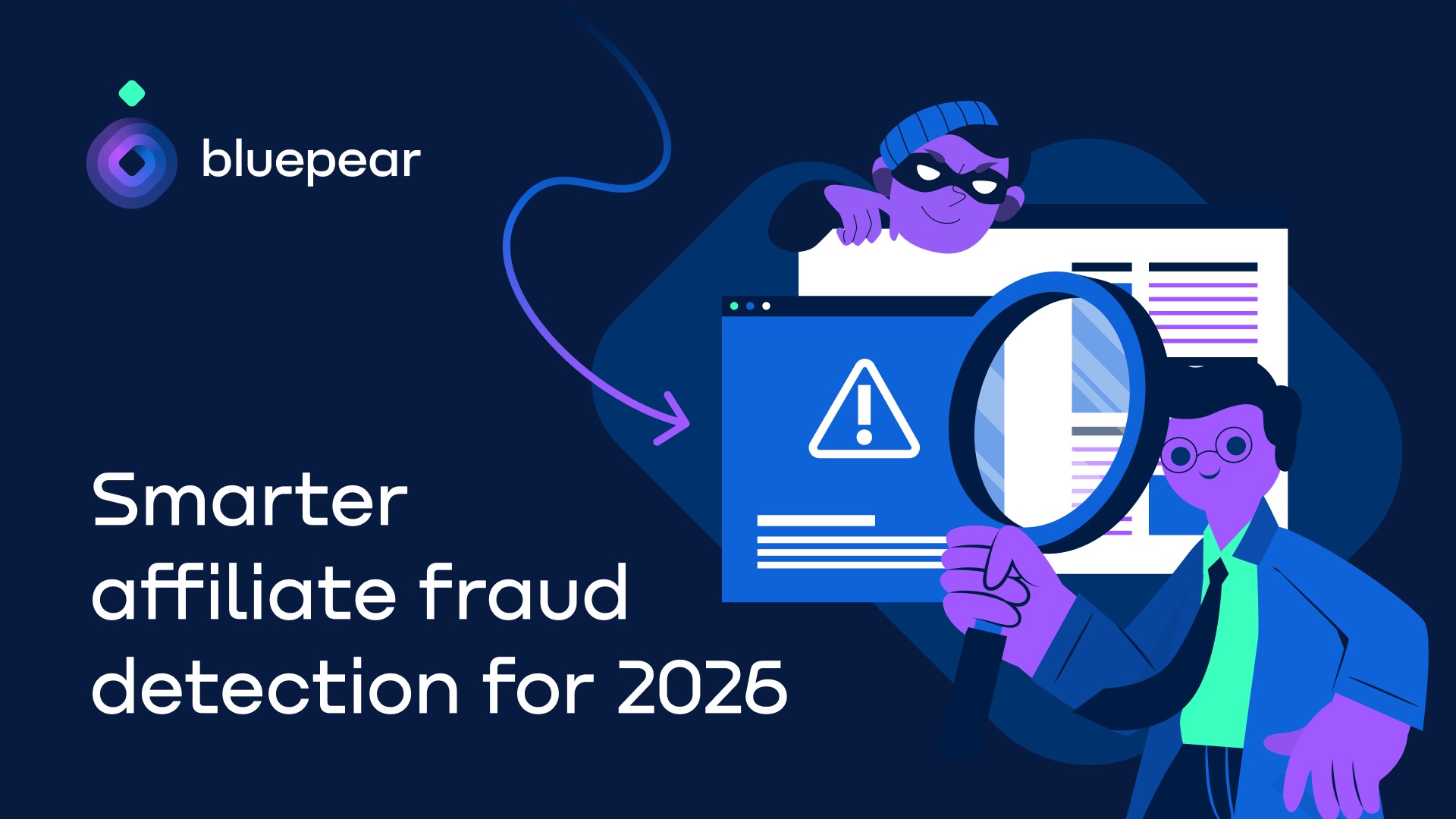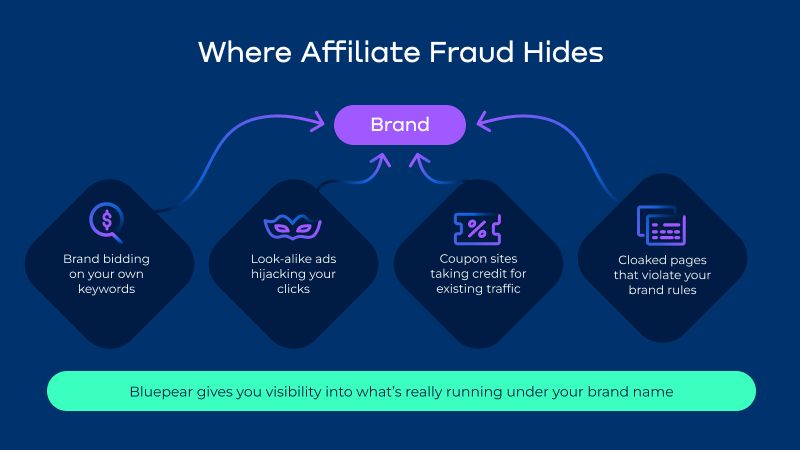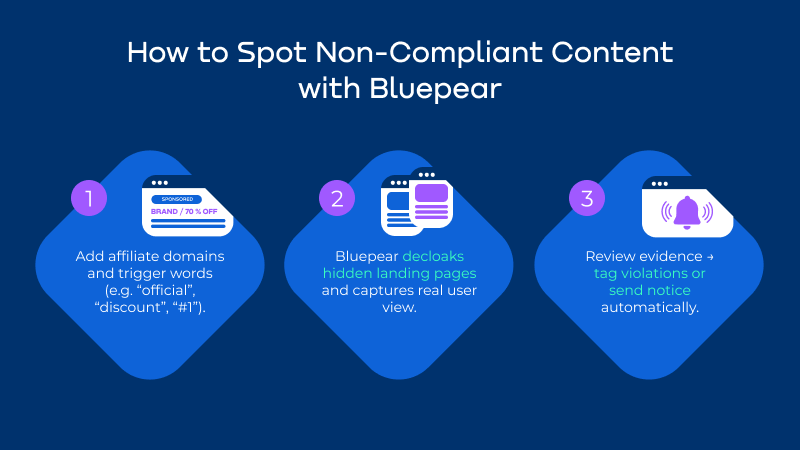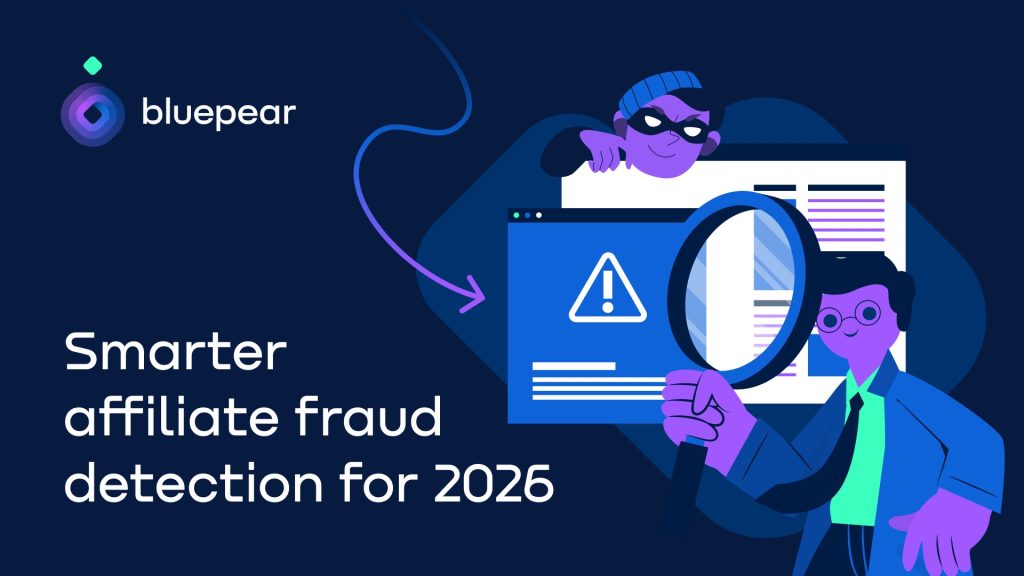Unmasking affiliate fraud: Protecting growth in 2026


Affiliate marketing drives billions in sales – and billions more in hidden losses.
Brand bidding, ad hijacking, coupon abuse, and more subtle forms of affiliate fraud can quietly drain ROI and distort attribution.
For performance leaders, the question isn’t if this happens, but how much you’re already losing.
This article breaks down the most common types of affiliate marketing fraud and shows how modern monitoring tools like Bluepear help brands protect growth, reputation, and spend through smarter affiliate fraud detection strategies.
Why affiliate programs are under threat
Not all affiliate programs are created equal – and neither are their incentives.
In SaaS especially, affiliate commissions can reach 20% to 70%, making the channel both profitable and highly attractive to fraudsters. The higher the reward, the stronger the temptation to bend the rules.
Affiliate program fraud relies on trust gaps – brands expect partners to follow program guidelines, and partners expect fair tracking and attribution. But when incentives are high and oversight is low, blind spots appear, and that’s exactly where affiliate fraud thrives.
Scammers exploit these gaps by bidding on brand terms, hijacking ads, or using expired coupon codes to claim unearned commissions. It’s no surprise that 63% of affiliate marketers cite affiliate program fraud as one of their biggest challenges – ranking even above algorithm changes or partner support issues.
So can you guess what the real problem is?
Yes, most of this affiliate marketing fraud happens out of sight.
Affiliates run campaigns, ads, and landing pages that brands rarely monitor in real time. Without automated affiliate fraud detection, you might keep paying commissions on traffic you already own – or worse, fund those who impersonate your brand – without realizing it until the damage is done.

Inside the fraud playbook
Affiliate fraud tactics evolve fast – often faster than most programs can react.
Below are the schemes that drain budgets and skew performance data the most, along with ways to recognize them early and shut them down using proper affiliate fraud prevention measures.
1. Brand bidding
You’ve seen it before – someone’s bidding on your brand name in search.
Users who were already looking for your product click an affiliate ad instead.
You pay a commission for a sale you would’ve closed anyway, your CPC on brand terms spikes, and your premium positioning gets diluted by promo-heavy copy using your name.
It’s one of the simplest forms of affiliate fraud – and one of the hardest to spot without the right visibility.
How to respond:
- Add a full list of brand and close-variant keywords to your affiliate T&Cs.
- Watch for unexplained spikes in specific affiliate performance.
- Check branded search results regularly to see who’s actually running those ads – and document what you find.
How to check it with Bluepear:
- Create a monitoring project and add your brand terms (e.g. brand, brand + coupon), target countries, and device types.
- Start monitoring – within about an hour, you’ll see the first ad data and evidence of potential non-compliance.
- Review the report, tag violations, and take action – from pausing the affiliate to sending a Cease & Desist notice.

2. Ad hijacking
Ad hijacking happens when an affiliate copies your paid search ads, pretending to be your brand.
Their lookalike ads push your legitimate campaigns out of the top spot, intercept the clicks, and redirect users through their tracking links.
From your dashboard, it just looks like a drop in clicks or conversions – but in reality, you’re paying commissions on traffic you already paid to acquire.
It’s one of the most damaging forms of affiliate fraud because it steals both spend and visibility.
How to spot it:
- Watch for sudden dips in clicks or impressions in your branded search campaigns.
- Run test searches from different devices or locations – if the ad copy looks identical to yours but the URL isn’t, that’s a red flag.
- Keep evidence (screenshots or redirect paths) to take quick action with your network or affiliate.
How to check it with Bluepear:
- Add your branded keywords and target countries to start monitoring.
- Bluepear automatically flags any affiliates running look-alike ads under the HIJACKER tag.
- Use the redirect data – especially the full click path – to identify the source and remove or block the affiliate before they drain more spend.

3. Coupon abuse
Coupon affiliates don’t always look like fraudsters – but many of them quietly divert your branded traffic and take credit for sales you already earned.
Here’s how it happens: your brand works with a large affiliate network that, in turn, lets coupon publishers join as sub-affiliates. Those sites then rank at the top of Google for queries like “[brand] + coupon” and insert tracking links back to your store.
To you, it looks like legitimate affiliate activity – until you start checking branded search results and find coupon sites sitting above your own domain.
By then, you’ve already paid commissions on non-incremental sales and lost visibility into who’s actually driving that traffic.
How to respond:
- Make it explicit in your T&Cs that coupon and sub-affiliate traffic must be pre-approved.
- Work only with networks that disclose their sub-affiliates and traffic sources.
- Run branded keyword checks regularly to catch coupon publishers before they dominate search results.
How to check it with Bluepear:
- Add branded queries such as “brand + code/promo/coupon/voucher” to your monitoring project.
- Bluepear detects coupon publishers in search results and tags them automatically under COUPON.
- Use the redirect chain and screenshots as proof to remove the source affiliate or escalate through your network.

4. Non-compliant content
Some of the most damaging affiliate violations hide in plain sight – or rather, behind it.
Affiliates can show your compliance team one version of a page, while real users see something completely different: misleading offers, off-brand claims, or fake “official” comparisons. This tactic is called cloaking – and it’s one of the main reasons why non-compliant content often goes undetected for months.
Even if those pages drive clicks, they quietly undermine your brand voice and mislead customers, turning what appears to be legitimate traffic into a reputational risk.
How to respond:
- Set strict creative and messaging rules for affiliates.
- Require pre-approval for sensitive or comparative claims.
- Treat content audits as an ongoing process – not a one-time review.
How to check it with Bluepear:
- Add partner website URLs and trigger words (like “official”, “discount”, “#1”) to your monitoring project.
- Bluepear uses decloaking technology to uncover what users really see – not just what affiliates want you to see.
- Review screenshots, redirect paths, and violation tags, then take action with a Cease & Desist notice or removal.

Building a smarter defense
Affiliate fraud isn’t a single event – it’s a moving target.
Protecting your program in 2026 means combining clear rules, continuous visibility, and technology that scales with you.
Keeping that spend protected has become a financial and operational priority.
1. Start with clear rules, not assumptions
Your affiliate terms are your first line of defense – and most programs underestimate their power.
Be explicit about what’s allowed and what isn’t.
Ban brand bidding, require full disclosure of sub-affiliates, and demand transparent landing pages. List penalties for violations and follow through consistently.
When the rules are clear, enforcement becomes simple – and defensible.
2. Treat affiliates like performance partners, not traffic sources
Strong programs are built on relationships, not reach.
Don’t approve affiliates just because they promise volume – understand how they drive it.
Ask about traffic sources, conversion mechanics, and alignment with your ICP.
If someone guarantees “instant conversions” but won’t show their methods, treat it as a warning sign, not an opportunity.
3. Visibility is your best protection
Fraud doesn’t announce itself – it hides in data gaps.
Run test searches from different devices, locations, and hours of the day.
Watch for anomalies in click-to-conversion times or branded traffic spikes.
The sooner you see irregularities, the faster you can protect your budget – and your reputation.
4. Automate what you can’t scale
Manual checks don’t scale, but automation does.
Platforms like Bluepear simulate real user behavior across geographies and devices to uncover hidden ads, decloak affiliate landing pages, trace redirect chains, and compile full evidence packs – screenshots, keywords, affiliate IDs.
Teams can tailor projects by brand and region, monitor as frequently as needed, and manage violations from a single dashboard – without adding operational overhead.
5. Make transparency part of your culture
Fraud prevention works best when it identifies honest partners, not just pursues violators.
Share verified data with compliant affiliates and celebrate clean traffic.
When partners know transparency is valued, the honest ones become your strongest allies in keeping the channel clean.
Looking ahead
Fraud tactics are becoming increasingly sophisticated, and most teams don’t realize the extent of their budget losses until they take a closer look.
Protecting growth today means knowing what’s really happening inside your affiliate program: across every keyword, every click, every landing page. When you can see it all, it’s easier to maintain clean spending, fix attribution, and build stronger partnerships that actually drive performance.
That’s what we built Bluepear for: to give brands clarity, not another dashboard.
You can start monitoring in minutes, see what your affiliates are really doing, detect violations before they cost you money, and safeguard both ROI and brand reputation.
The first 7 days are free – start monitoring today and make sure your spend works as it should.







Recent Comments